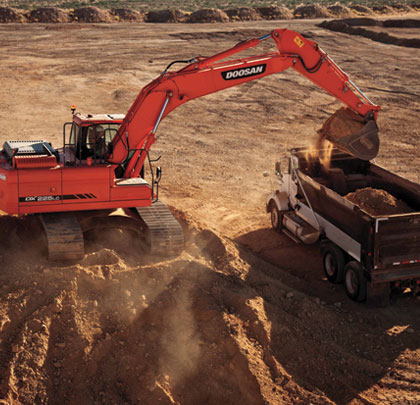Like the Sage investment advice, “buy low, sell high,” crawler excavators have a greater return on investment when a highly productive lifecycle is paired with a low total cost of ownership. While an excavator’s longevity is impacted by a wide variety of variables, you can control many of your outcomes through selecting the right machine, tending to the right maintenance, and following the right operation, says Chad Ellis, Doosan product manager.
“Today’s equipment owners are looking to capitalize on technologies and best practices that will drive down the total cost of ownership. By focusing on the fundamental fleet strategies that most directly influence your assets, you can improve operating efficiencies, extend lifecycles, and get the most out of your excavator,” Ellis says. He recommends these 10 tips to maximize the life of your machine—regardless of make or model:
THE RIGHT MACHINE
1. Select a machine correctly for the application. Whether clearing debris and vegetation, trenching in utilities, heavy digging, or performing demolition activities, you need a durable machine and attachments with the capacity to match the type of work you’re routinely performing. For example, specify a wheel excavator if your jobsite requires traveling primarily on paved surfaces. A wheel excavator can also easily navigate gravel or blacktop base before it’s paved. Core excavator specifications that should be taken into consideration include:
- Engine horsepower
- Operating weight
- Arm breakout force
- Hydraulic flow
- Maximum digging depth
- Maximum reach at ground level
- Maximum dump height
- Carrier clearance with boom
2. Properly partner capacities to capabilities. Match bucket size to the density of jobsite materials and productivity targets.
3. Provide power and protection. Determine hydraulic power needs to accommodate your level of attachment use. If you’re primarily using two-way flow attachments, it’s important to make sure a machine has a two-way hydraulic setup to accommodate the demand. Use guards and/or shields that protect an excavator’s undercarriage and axles in harsh conditions.
THE RIGHT MAINTENANCE
4. Follow routine maintenance schedules. Perform daily lubrication duties in addition to other key maintenance intervals recommended by manufacturers. Utilizing telematics with a fleet management system designed to help track maintenance intervals, and checking engine codes, can help improve maintenance by reducing guesswork. Routine maintenance should also include visual inspections of tracks or tires, attachments, and machine structures for damage.
5. Modify maintenance intervals to accommodate special conditions or attachments. Extremely dusty applications may require more frequent air filter cleaning and use of engine precleaners. An excavator’s attachments, such as buckets, hydraulic breakers, and clamps, are some of the most popular and hardest-working tools and deserve the same attention as the machine itself. Component checks should include hoses, boom, and arm cylinders, as well as wear plates, bolted-on cutting edges, and attachment mechanisms to make certain they fit snugly and properly.
6. Limit excessive machine travel or idling time. By selecting the proper power mode for a particular task, operators can improve fuel efficiency. Likewise, reducing the amount of idling that can occur during loading and unloading operations by maximizing utilization is a good practice to increase profitability.
THE RIGHT OPERATION
7. Provide training for safe and proper operation of equipment. Having a solid understanding of all the various functions of an excavator not only increases productivity, but it can avoid unnecessary accidents. At the same time, by providing hands-on training, operators can learn an excavator’s controls faster and distinguish which features will produce better results in certain applications.
8. Avoid excessive power. Operators with an understanding of a machine’s various optimum power modes know they should avoid improper power mode use; rather, they should set up the machine to deliver power that is adequate for their operation. Likewise, operators who maximize productivity put themselves in a position to protect engine systems and structural components from stress.
9. Establish machine limits. Operators who are trained on the proper operation of an excavator develop a better understanding of a machine’s limits and the consequences for activities that push machines beyond rated capacities. For example, operators should lift only within rated tipping loads. Operators should always lift squarely over the side or over the end of the machine. If equipped, they should select the lifting mode on the excavator before using the machine for lifting work.
10. Strive for optimum sight lines. Many manufacturers have addressed compromised sight lines to increase visibility. In addition to reducing component obstructions, the cab designs of some manufacturers’ excavators provide windows that offer 360-degree visibility. Being able to see a machine’s tracks, the bucket’s sides and its many other attachments when digging is critical to an operator.
Maximizing an excavator’s life from the moment you purchase it can pay big dividends through increased productivity, the reduction of maintenance surprises, and safer, more efficient operation. When a highly productive lifecycle is achieved in tandem with a lower total cost of ownership, it’s a win-win for you and your customers. ■
For More Information:
Article supplied by Bobcat Company headquartered in West Fargo, North Dakota. For more information, visit www.bobcat.com.
_________________________________________________________________________
Modern Contractor Solutions, September 2013
Did you enjoy this article?
Subscribe to the FREE Digital Edition of Modern Contractor Solutions magazine.



